Abstract
All Friend cells--except thymidine kinase (ATP:thymidine 5'-phosphotransferase, EC 2.7.1.21)-deficient mutants--are highly inducible for the release of biologically active spleen focus-forming virus (SFFV) after exposure to BrdUrd. We studied SFFV production in somatic cell hybrids made between Friend leukemia cells (FLC) and cells expressing various differentiation programs. High inducibility of SFFV and release of constitutive Friend virus (FV) and SFFV are eliminated in all hybrids in which the potential for erythroid differentiation is suppressed. FV release and its induction by BrdUrd are unchanged in hybrids that maintain the expression of erythroid differentiation.
Full text
PDF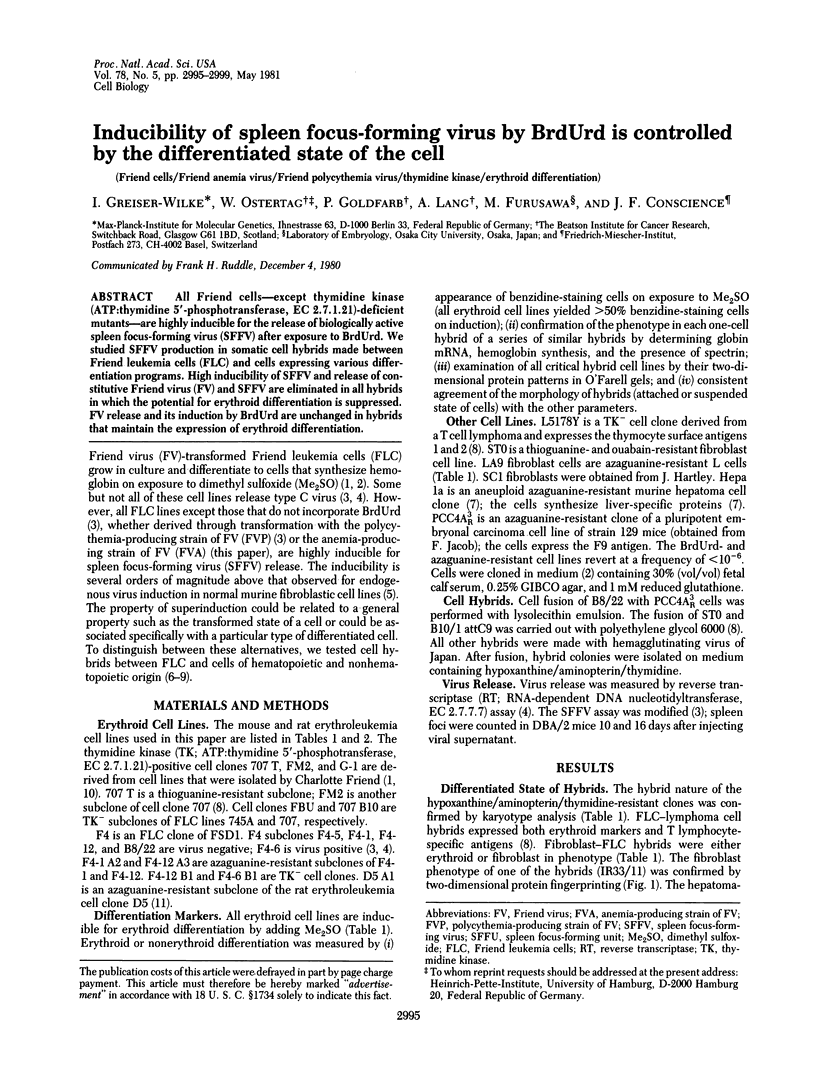
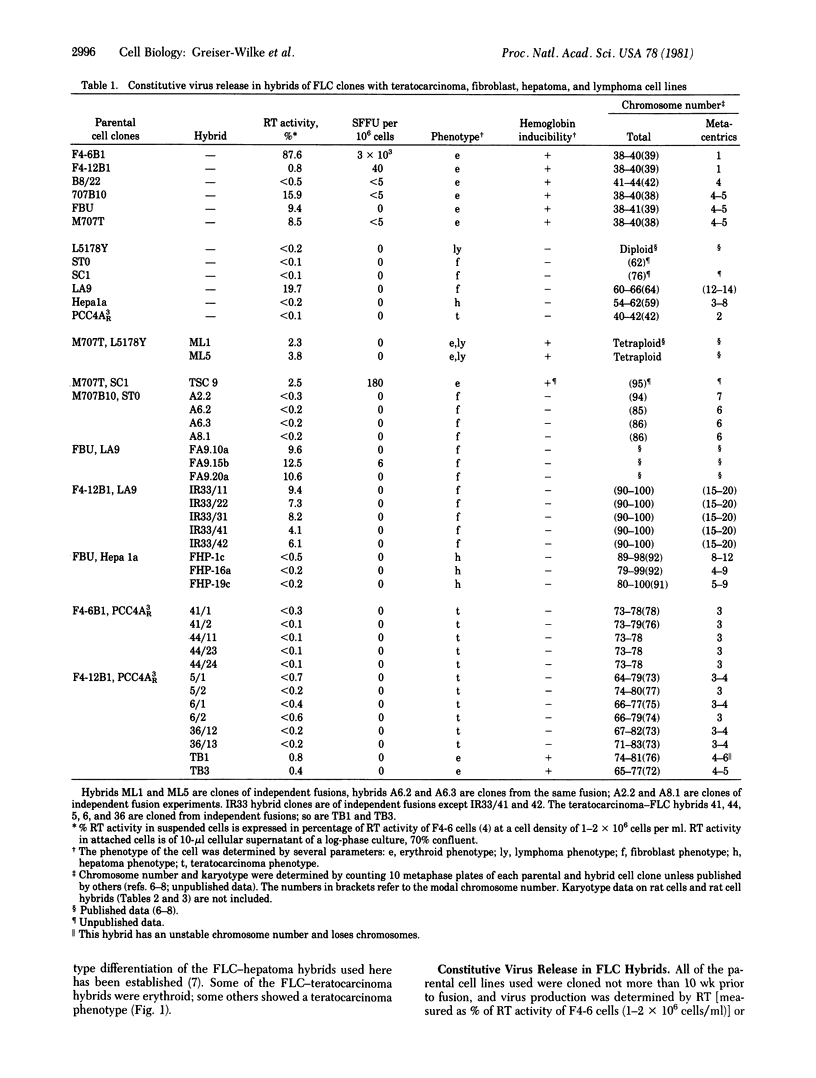
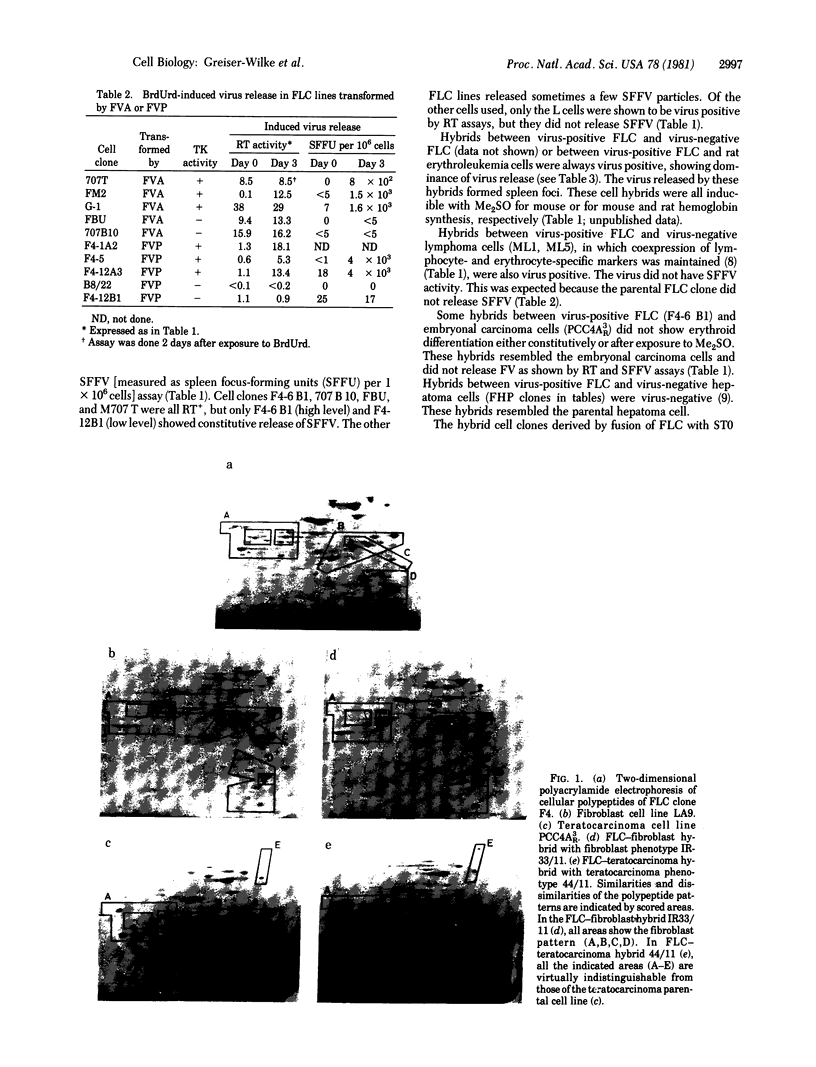
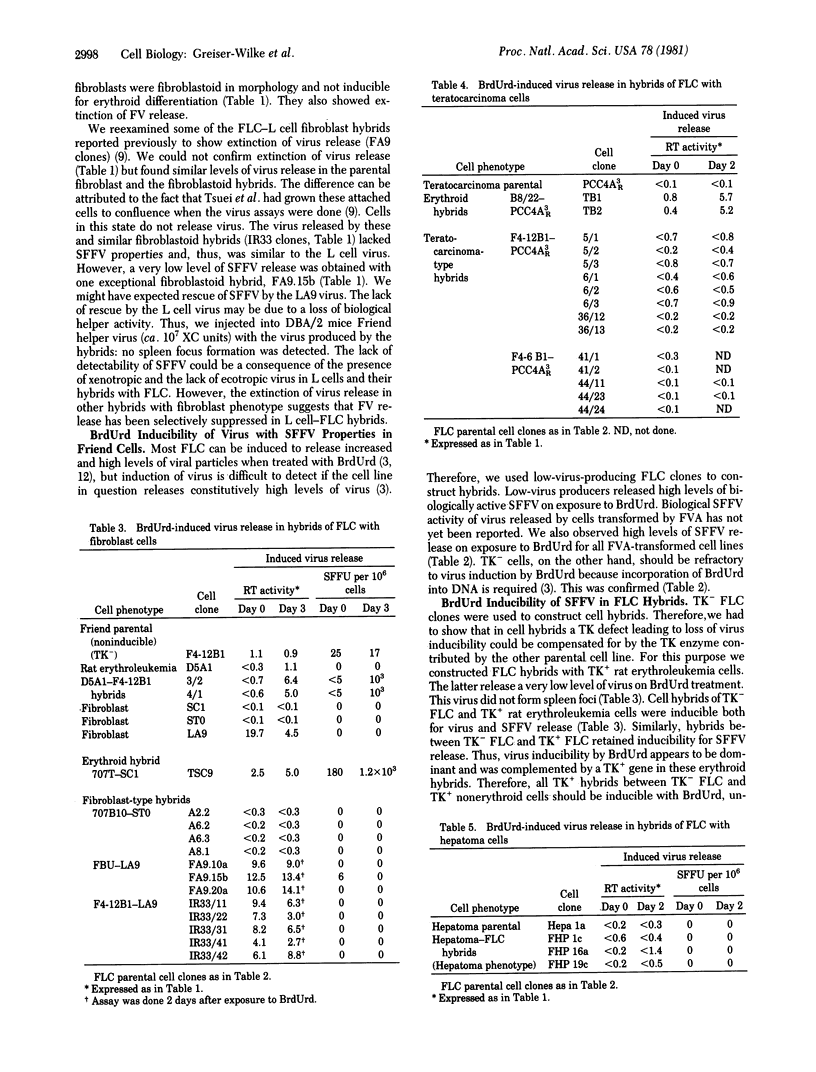
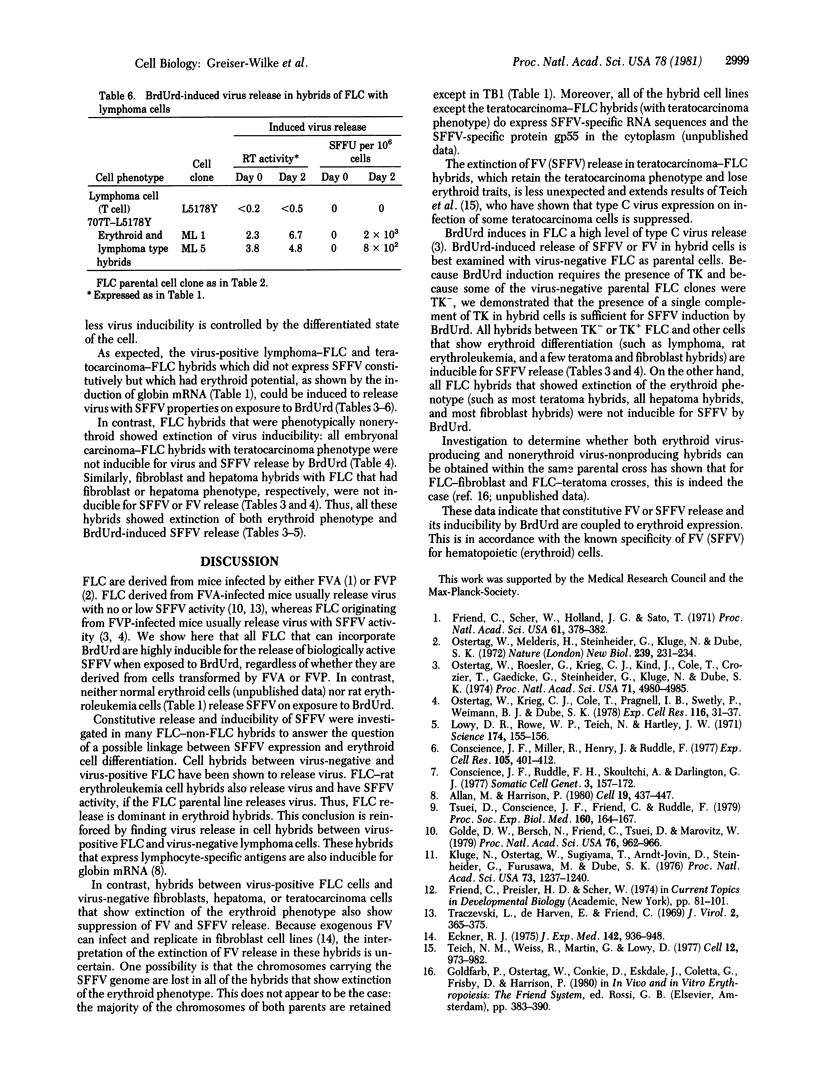
Images in this article
Selected References
These references are in PubMed. This may not be the complete list of references from this article.
- Allan M., Harrison P. Co-expression of differentiation markers in hybrids between Friend cells and lymphoid cells and the influence of the cell shape. Cell. 1980 Feb;19(2):437–447. doi: 10.1016/0092-8674(80)90518-8. [DOI] [PubMed] [Google Scholar]
- Conscience J. F., Miller R. A., Henry J., Ruddle F. H. Acetylcholinesterase, carbonic anhydrase and catalase activity in Friend erythroleukemic cells, non-erythroid mouse cell lines and their somatic hybrids. Exp Cell Res. 1977 Mar 15;105(2):401–412. doi: 10.1016/0014-4827(77)90137-9. [DOI] [PubMed] [Google Scholar]
- Conscience J. F., Ruddle F. H., Skoultchi A., Darlington G. J. Somatic cell hybrids between Friend erythroleukemia cells and mouse hepatoma cells. Somatic Cell Genet. 1977 Mar;3(2):157–172. doi: 10.1007/BF01551812. [DOI] [PubMed] [Google Scholar]
- De Tkaczevski L., De Harven E., Friend C. Structure and leukemogenic activity of a murine leukemia virus. J Virol. 1968 Apr;2(4):365–375. doi: 10.1128/jvi.2.4.365-375.1968. [DOI] [PMC free article] [PubMed] [Google Scholar]
- Eckner R. J. Continuous replication of Friend virus complex (spleen focus-forming virus-lymphatic leukemia-inducing virus) in mouse embryo fibroblasts. Retention of leukemogenicity and loss of immunosuppressive properties. J Exp Med. 1975 Oct 1;142(4):936–948. doi: 10.1084/jem.142.4.936. [DOI] [PMC free article] [PubMed] [Google Scholar]
- Friend C., Preisler H. D., Scher W. Studies on the control of differentiation of murine virus-induced erythroleukemic cells. Curr Top Dev Biol. 1974;8:81–101. doi: 10.1016/s0070-2153(08)60606-7. [DOI] [PubMed] [Google Scholar]
- Friend C., Scher W., Holland J. G., Sato T. Hemoglobin synthesis in murine virus-induced leukemic cells in vitro: stimulation of erythroid differentiation by dimethyl sulfoxide. Proc Natl Acad Sci U S A. 1971 Feb;68(2):378–382. doi: 10.1073/pnas.68.2.378. [DOI] [PMC free article] [PubMed] [Google Scholar]
- Golde D. W., Bersch N., Friend C., Tsuei D., Marovitz W. Transformation of DBA/2 mouse fetal liver cells infected in vitro by the anemic strain of Friend leukemia virus. Proc Natl Acad Sci U S A. 1979 Feb;76(2):962–966. doi: 10.1073/pnas.76.2.962. [DOI] [PMC free article] [PubMed] [Google Scholar]
- Kluge N., Ostertag W., Sugiyama T., Arndt-Jovin D., Steinheider G., Furusawa M., Dube S. K. Dimethylsulfoxide-induced differentiation and hemoglobin synthesis in tissue cultures of rat erythroleukemia cells transformed by 7,12-dimethylbenz(a)anthracene. Proc Natl Acad Sci U S A. 1976 Apr;73(4):1237–1240. doi: 10.1073/pnas.73.4.1237. [DOI] [PMC free article] [PubMed] [Google Scholar]
- Lowy D. R., Rowe W. P., Teich N., Hartley J. W. Murine leukemia virus: high-frequency activation in vitro by 5-iododeoxyuridine and 5-bromodeoxyuridine. Science. 1971 Oct 8;174(4005):155–156. doi: 10.1126/science.174.4005.155. [DOI] [PubMed] [Google Scholar]
- Ostertag W., Krieg C. J., Cole T., Pragnell I. B., Swetly P., Weimann B. J., Dube S. K. Induction of intracisternal A-type particles during Friend cell differentiation. Exp Cell Res. 1978 Oct 1;116(1):31–37. doi: 10.1016/0014-4827(78)90061-7. [DOI] [PubMed] [Google Scholar]
- Ostertag W., Melderis H., Steinheider G., Kluge N., Dube S. Synthesis of mouse haemoglobin and globin mRNA in leukaemic cell cultures. Nat New Biol. 1972 Oct 25;239(95):231–234. doi: 10.1038/newbio239231a0. [DOI] [PubMed] [Google Scholar]
- Ostertag W., Roesler G., Krieg C. J., Kind J., Cole T., Crozier T., Gaedicke G., Steinheider G., Kluge N., Dube S. Induction of endogenous virus and of thymidine kinase by bromodeoxyuridine in cell cultures transformed by Friend virus. Proc Natl Acad Sci U S A. 1974 Dec;71(12):4980–4985. doi: 10.1073/pnas.71.12.4980. [DOI] [PMC free article] [PubMed] [Google Scholar]
- Teich N. M., Weiss R. A., Martin G. R., Lowy D. R. Virus infection of murine teratocarcinoma stem cell lines. Cell. 1977 Dec;12(4):973–982. doi: 10.1016/0092-8674(77)90162-3. [DOI] [PubMed] [Google Scholar]
- Tsuei D., Conscience J. F., Friend C., Ruddle F. H. Co-suppression of virus production and erythroid differentiation in Friend erythroleukemic cell X non-erythroid mouse cell hybrids. Proc Soc Exp Biol Med. 1979 Feb;160(2):164–167. doi: 10.3181/00379727-160-40411. [DOI] [PubMed] [Google Scholar]







